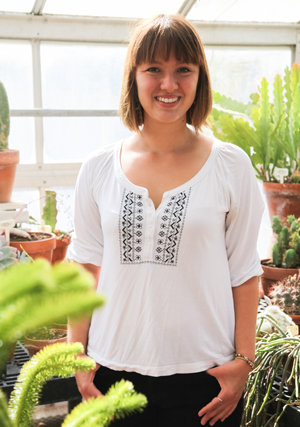Wading her way through dense thickets of Scotch Broom in Washington state, Jennifer Thompson, 22, realized just how damaging the plant could be.
Growing up to 12 feet in height, the perennial shrub with its bright yellow flowers had overrun land once filled with Douglas fir. But what was most interesting to Thompson was the fact that, even if all the Scotch Broom were removed, the Douglas fir would most likely not regrow.
Thanks to a grant from UC Santa Cruz's Dean's Fund for Undergraduate Research and to Professor of Ecology and Evolutionary Biology Ingrid Parker, Thompson (Cowell '15, plant sciences) spent a year doing research into the question of why the Scotch Broom was so toxic to Douglas fir.
Thompson's work also was emblematic of a UC Santa Cruz ethos grounded in the founding days of the university: the opportunity for undergraduates to take part in research. In fact, a 2014 study conducted by the university found 73 percent of graduating seniors had assisted in faculty research or creative projects during their time at UC Santa Cruz.
Thompson's research project was time-consuming. First she grew Scotch Broom and Douglas fir seedlings in a campus greenhouse and then isolated the mycorrhizal fungi that give nutrients to plants' roots, including Douglas fir. She sequenced the fungi's DNA, extracted allelopathic chemicals from the Scotch Broom that are released into the soil, and then documented their effect on the different fungi.
It turned out the alkaloids from Scotch Broom inhibited the growth of most of the crucial fungi. Only a few types seemed able to tolerate it.
"Jennifer's research is remarkable in the way it bridges very different fields," said professor Parker. "She has done everything from fieldwork in Washington, to the extraction and HPLC analysis of the chemical compounds in her plants, to the isolation and culturing of mycorrhizal fungi, to the DNA sequencing of those fungi."
Thompson's results, Parker said, "may explain why we see very poor survival of Douglas fir seedlings in areas that are invaded by the shrub."
For Thompson, the research project was creative and rewarding.
The creative part, she said, was designing an experiment that would answer an important question. The reward was discovering something that may help restoration efforts.
Someday, Thompson speculated, mycorrhizal fungi might be inoculated back into the soil, setting the stage for Douglas fir forests to rise again.
"I like it when research like this has an application," she said.
After graduation this summer, Thompson, who had planned to go into medicine until she started working at one of UC Santa Cruz's greenhouses and discovered a passion for plants, is headed to Panama to intern at the Smithsonian Tropical Research Institute.
This will be her third time at the research institute, including a field course with UC Santa Cruz Professor of Environmental Studies Gregory Gilbert that led her to an interest in plant fungal ecology and the idea of going to graduate school.
Tromping through forest and jungle, peering through microscopes, and writing her results gave a new dimension to Thompson's college years.
"Coming into college, I didn't think I could do any of this," Thompson said. "It gave me more confidence. I feel more confident about my future because of it."
The 18th annual Undergraduate Research Poster Symposium for science and engineering students is 2-4 p.m. June 4, at the Jack Baskin School of Engineering courtyard.



